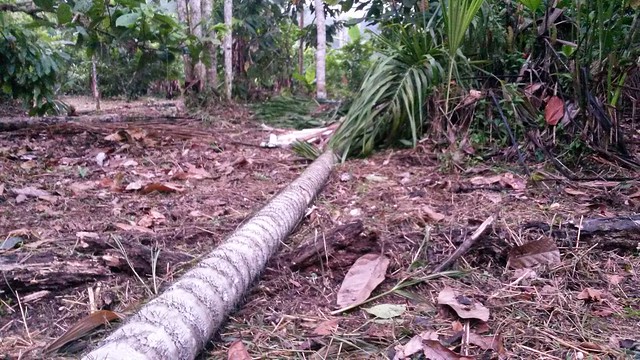Chontacuro: The worm of Amazon culture and sustainable development
By Clint S.
April 4, 2016
Inside the hut in which we were gathered, Margarita held out a bowl filled with inch-long worms still squirming with life. She didn’t say a word in English, Spanish or her native Tucanoan. She simply gave a look that said, “Go for it if you want,” — and honestly, that was all she had to do. It was the moment that had been anticipated for much of the trip.
I grabbed one of the creamy white worms by its firm head before I had the chance to think twice and bit down on the worm’s tough, rubbery body. With a grinding of my teeth and yank of my jaw, I managed to decapitate the worm into my mouth — and my taste buds began to experience this gastronomic taboo that had somehow wiggled its way into the curriculum of our study abroad program.
To my surprise, after a few seconds, the worm hit with a strong, unique flavor that wasn’t horrible. I tossed the worm’s head off to the side and began to encourage my classmates to try a worm. After about 10 minutes and plenty of grimaces, squeals and laughs, a total of four of us had eaten one of these raw worms known as chontacuro.
The chontacuro worm is common in the diet of several indigenous groups of the Amazon. It gets its name from the Kichwa words curo, which means worm, and chonta, which is the name of the palm tree where the little squirmsters are found.
The indigenous people’s process of obtaining chontacuro is as unique as the worm’s flavor. Indigenous families grow the chonta palm (Bactris gasipaes) in the agroforest gardens located next to their houses known as chacras. A walk through one of these chacras presents a profusion of banana trees casting shade down onto cocoa plants, vanilla vines winding up cinnamon trees, and pineapple and lemongrass plants dotting the forest floor. The slender chonta palm rises above the compound of crop diversity below and finds sunlight in the canopy. The tree produces a fruit known as chontaduro, which is cooked and eaten by the families. Inside the pinnacle of the trunk are the palm hearts, known as palmitos, which are also harvested and eaten.
After about four years, a chonta palm has grown to a height that is difficult to harvest fruit from, so, with a simple ax, the tree is cut down. But the family doesn’t immediately chop up the tree and carry it off. They leave the fallen trunk right where it is as a new and inviting home for chontacuro.

In two months’ time, the chontacuros have completely eaten out the trunk’s interior, leaving the exterior perfectly intact. At this point, the indigenous families harvest out the worms they have intentionally provided an ideal home for larval growth. The natives of the jungle literally farm these worms.
When Margarita entered the hut where our class waited with the bowl of worms, she was returning from retrieving the chontacuros from her husband, who had harvested them from the chacra earlier.
After the frenzy of trying the worms raw, Margarita toasted up the rest of the bowl on kebab skewers for us. Nearly everyone in the class wriggled up the courage to try them toasted. (Even Dr. Heidi Appel, who had already tried chontacuro on last year’s program, seized the opportunity.) The toasty crunch went well with the worm’s unique flavor.

Margarita’s act of providing our class with the opportunity to try chontacuros aligned with a paramount facet of our course’s content — sustainable development. We weren’t the first group of outsiders that she had offered chontacuros. Many tourists staying in ecolodges in Cuyabeno National Park come down the river to visit Margarita’s community.
The introduction of oil companies into the Ecuadorian rain forest has caused deforestation and disrupted the lives of the indigenous living here. However, some communities, like Margarita’s, have chosen to turn down the oil companies’ cash offers that would have allowed them access into the precious interior of the forest. These communities have turned to alternative modes of development that are compatible with the preservation of the Earth’s lungs — such as ecotourism.
“Margarita has started her own project in this community with the chontacuros,” said ecotourist guide Davíd. “Most of her community has lost their ways of actually collecting and eating the chontacuro.”
Throughout the years of contact with outside society, Margarita has chosen to preserve this facet of culture and to share it with ecotourists.
When our guide, Davíd, translated our words of gratitude to Margarita, she didn’t reply with a long oration, but rather gave us a warm smile and continue to watch over her children who had been running around. We then left the community and began to ride back up to the lodge. As the view of the community disappeared behind a bend in the river, I was left with the taste of toasted chontacuro and the admirable image of Margarita as an entrepreneur in the world of ecotourism and sustainable development.
About the blogger
Clint S. studied abroad on the Ecuador: Biology, Culture and Sustainability program.